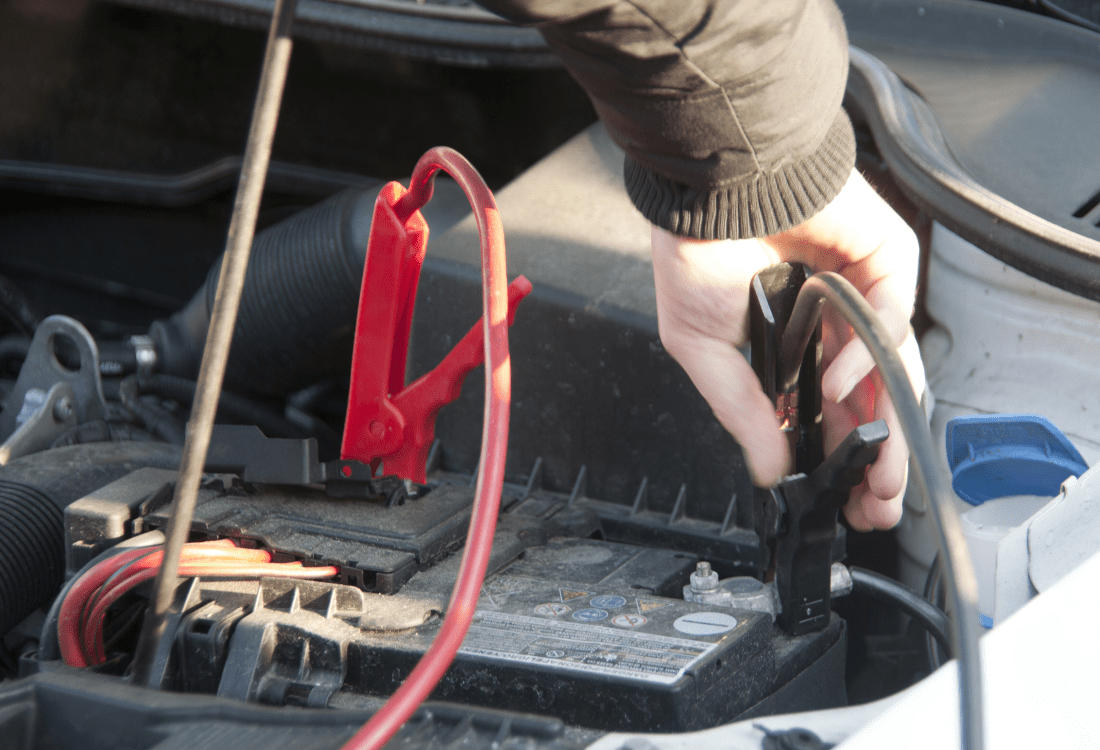
26 Jun To Jump or Not to Jump (a Battery)—That is the Question
It’s likely that you’ve experienced the inconvenience of a dead battery at some point or another—particularly if it left you stranded on the road.
While jumper cables are typical components in a roadside emergency kit, you should use caution before using them, particularly, if you’ve never been in the position to jump a battery or if you are driving a vehicle provided for your business and/or personal use by your company.
As with anything technological, there is a right way and a wrong way to handle a battery jump.
Check Your Policy
Before making any decisions about jumping your battery, review your fleet’s safety and accident policy, which should always be stored in the glovebox. Depending on the policy, you may be required to call the company’s roadside maintenance provider for assistance. You may also be required to inform fleet personnel if you’ve had a battery issue—since a dead battery also could indicate other maintenance issues that need to be addressed.
More important, you may be prohibited from jumpstarting your assigned vehicle’s battery on your own. This is because incorrectly jumpstarting your battery could cause serious damage to your or a good Samaritan’s vehicle—including fires or explosions. Although it may be tempting, the National Safety Council recommends that you do not flag down other vehicles to help you if you are not already traveling with another vehicle.
Official assistance can prevent any potential damage to your car caused by someone who is untrained. Even if you know the proper method to jumpstart a battery, it is often better left to professional roadside assistance teams to handle the jumpstart, since they have professional-grade equipment that can determine if it is indeed the battery that is at issue or some other electrical issue, and roadside assistance services likely carry liability insurance that will cover any mistakes that they may cause.
However, if your policy does permit you to jumpstart your own battery, it’s important to know the right way and the wrong way to perform this task.
The Wrong Way
Jumpstarting a vehicle the wrong way can cause more headaches than a stranded vehicle and missing an appointment.
While jumpstarting the vehicle, do not smoke, light a match, or do anything else that may create a spark. If you are jumpstarting an older car with a 6-volt battery, do not use a newer car with a 12-volt battery. This can cause the 6-volt battery to explode. (This isn’t likely to be an issue since most manufacturers switched to 12-volt batteries in the mid-1950s, but we would suggest checking anyway and avoid receiving a jump from a motorcycle or a classic car in a reverse situation.) Finally, you won’t find a friend in an electric vehicle to be of much help. They won’t have a traditional lead-acid 12-volt battery to help you out.
Do not exit the vehicle if you are on a highway—particularly, if your vehicle stopped working in highway traffic. Instead, you will need to call roadside assistance. Exiting a vehicle on a highway significantly increases the likelihood of injury or even death.
If it is safe to jumpstart the vehicle, be careful to not let the cables dangle into the engine compartment when you are connecting each clamp to the appropriate battery.
Do not jumpstart the battery terminals if they are dirty or corroded. If they are, try cleaning them with baking soda and water. If you don’t have these products handy, Coca-Cola can work in an emergency.
The Right Way
Again, if it is permitted by fleet policy, there are several steps you need to take to correctly and safely jumpstart your vehicle:
- Make sure you park the vehicles close to each other, but don’t let the vehicles touch.
- Shut off the ignition of both cars while you setup the cables, as well as any other accessories that may drain power, such as internal lights and the stereo system. Connect the red positive clamp to the dead battery’s positive (+) post, and connect the other red clamp to the positive (+) post of the charged battery.
- Connect the black negative clamp to the working vehicle’s negative (-) battery post, and then connect the other black clamp to the dead car’s unpainted metal surface.
- Check that all of the cables are secure. Start the working car and let it sit for a few minutes to start charging the dead battery.
- It is important that you turn the headlights and heater blower motor on, because they can absorb voltage spikes that are potentially harmful to your vehicle.
- Once you think the battery has enough juice, try to start the dead vehicle and let them idle together.
Your car should start if the process was completed properly. Finally, you will need to carefully disconnect the cables in reverse order and drive your vehicle for about 30 minutes in order to recharge the battery. When you’re finished driving, park in a safe place in case the battery is defective or there are indications that you’re having other electrical problems.
If you cautiously execute all of these steps, you should be back on the road in no time.
Safe driving!



No Comments